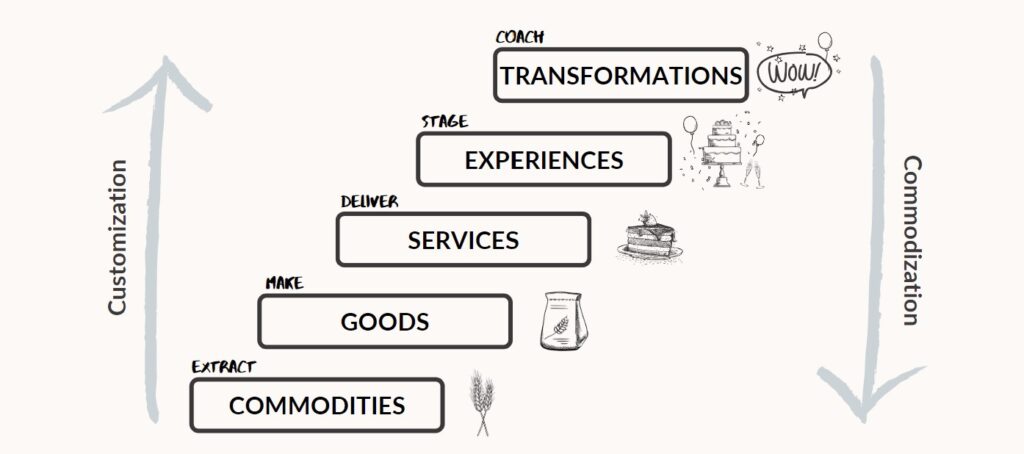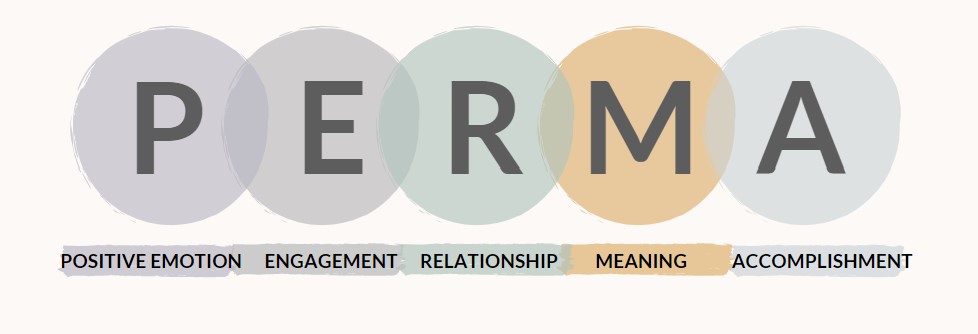The arrival of the experience economy has left consumers craving more extraordinary and memorable experiences. Consumers are now in charge of their own experiences by co-creating and customising them on the go. The ‘Experience Design Roadmap’ conceptualises this idea and could be used as a manual to facilitate human-centred, co-created, memorable and transformative tourism experiences.
Experience Design: What is it again?
Experience Design. A term, we are hearing frequently in combination with the term ‘experience economy’ – but what are we exactly talking about? The term experience design represents the design of experiences that engage individuals emotionally, leave long-term memories, and have the potential to transform customers. Simultaneously, experience design can be seen as part of the ‘ladder’ of the experience economy as shown below. Customers in various industries – ranging from tourists, to supermarket visitors, and students to your own colleagues – want to purchase products and services.
However, it goes beyond that: people want to buy extraordinary and memorable experiences. The field of experience design can teach us how to extend our offer into the experience economy and create unforgettable experiences. In addition, with the rise of information and communication technologies (ICTs), and people spending a lot of time behind the screen or are supported by ICTs, the nature of experiences has changed too.

Source: Based on Pine & Gilmore (2011)
.
Experience Design comes in many sizes and shapes: pick your choice!
The purpose of experience design is manifold in character it does not only create new experiences but has also the power to improve existing products, services, and even experiences. In the tourism field, experience design can be used when creating a new hotel concept, but it can also be implemented to enhance a museum experience with digital technology or improve a dining experience at a restaurant.
In other words, designing experiences requires businesses to plan and implement how an experience takes place and to think strategically about how it co-creates value for and with its consumers. Therefore, experiences do not occur by chance but are the outcome of an intentional design process.
Experience Design Roadmap: Designing Experiences in the 21st century
Various scholars including Pine & Gilmore, Neuhofer, Tussyadiah and Sheldon have set out principles and core features of designing experiences and design principles. The Experience Design Roadmap (Figure 2) combines the design-thinking process and principles into one graphic.

Source: Neuhofer (2022) – Encyclopedia of Tourism Management and Marketing
.
First of all, the core features of the experience design process include being human-centered, iterative, and holistic (Tussyadiah, 2014). Human-centeredness highlights the needs, wants, and desires of tourists throughout all stages of their journey, whereas iteration explains the process of moving back and forth between prototyping and refining a design based on consumer feedback. Lastly, a holistic approach means taking contextual details into account to optimise human experiences. Moreover, in order to design tourism experiences, it is recommended to develop a strategic positioning and identify opportunities as design principles to create value for tourists.
Second, Pine and Gilmore (1999) suggest five design principles: 1) attach a theme to an experience (e.g. story, movie, authentic elements), 2) enhance the experience with positive touchpoints (e.g. add surprises, create wow moments, plan a strong start/finish to an experience), 3) eliminate negative touchpoints (e.g. waiting, queuing, service failures), 4) design experience memorabilia (e.g. tangible souvenirs), and 5) engage all five senses (e.g. the smell of a bakery, dinner in the dark, virtual reality technology). Through a unique mixture of these elements, a valuable experience can be created for customers.
Third, ICTs have opened up new opportunities regarding how tourists connect, interact, and co-create experiences with one another during the various travel stages. As a result, an integrated physical and virtual space in which so-called technology-enhanced tourist experiences, can be designed (Neuhofer et al., 2014). As digital realities have to be taken into account when designing experiences, the following design principles should be kept in mind: experiences should be designed for 1) co-creation among stakeholders (e.g. businesses, employees, locals, other customers, their own social circles) and 2) digital technology engagement (e.g. to communicate, inform, and enhance experiences).

Source: Based on Martin E.P. Seligman
.
Finally, beyond memorable and technology-enhanced experiences, consumers have also been increasingly seeking experiences that fulfil the need for self-actualisation, personal growth, and transformation (Sheldon, 2020). Taking positive psychology into consideration, experiences should encompass 1) positive emotions (e.g. happiness, positive surprises, the fear of missing out), 2) engagement (e.g. excitement, interactions, surreal aesthetics), 3) relationships and the self (new encounters, reuniting, communitas), 4) meaning (e.g. sense of unity, lifestyle, selfexpression), 5) accomplishment of the self (self-discovery, reassessment, memories), and 6) liminality of time and space (storytelling, aesthetics, stimulation of the senses) (Neuhofer et al. 2020). For example, large-scale electronic music festivals and events, authentic cultural gatherings, or tourist attractions and leisure experiences can all be designed for the purpose of transformation.
…
Now is the time to adjust your services and products and co-create in the light of the experience economy. Now it’s the time to experience (design)!
.
Cite as:
Neuhofer, B. (2022). Experience design. In: Buhalis (Ed.) Encyclopedia of Tourism Management and Marketing. Edward Elgar Publishing.
Link to the chapter – ElgarOnline
